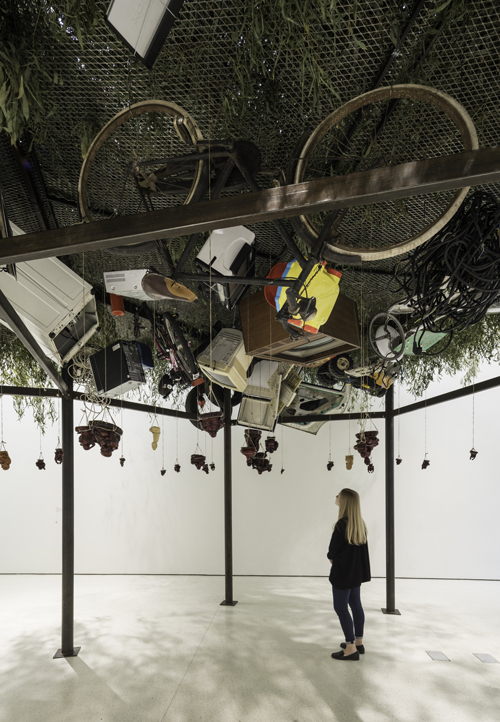
Fu Dao/Fu Dao, Upside-Down Buddha/Arrival at Good Fortune, 1997
Chen Zhen, Precipitous Parturition, 1999. Rubber bicycle inner tubes, aluminum and plastic toy cars, metal, fragments of bicycles, silicon, and paint, length: approximately 20 m, diameter: approximately 150 cm. Pinault Collection, Paris © Chen Zhen. Photo: Chen Zhen

Chen Zhen, Fu Dao/Fu Dao, Upside-Down Buddha/Arrival at Good Fortune, 1997. Steel, bamboo, resin Buddha statues, washing machine, computer monitor, tires, bicycle, fan, chair, household appliances, other found objects, and string, approximately 500 × 800 × 650 cm overall. Courtesy GALLERIA CONTINUA, San Gimignano/Beijing/Les Moulins/Havana © Chen Zhen. Photo: Chen Zhen;
Art and China after 1989: Theater of the World is a large exhibition of contemporary art from China that spans the years 1989 to 2008, which can be seen as the most transformative period of modern Chinese and recent world history. The period extends from the end of the Cold War and the spread of globalization to the rise of China as a global presence, culminating in the 2008 Beijing Olympics. The exhibition highlights approximately 70 key Chinese artists and artist collectives and features nearly 150 experimental works in film and video, installation, painting, sculpture, photography, performance, and socially engaged art and activist art. The show is organized in six chronological and thematic sections occupying the second floor at the Guggenheim Museum Bilbao.
“I’m not playing with misunderstanding. I’m trying to create it.” [1]
Born in 1955 in Shanghai to a family of doctors, Chen Zhen was a conceptual artist and sculptor who lived in Paris. Chen’s work explores the realities of the human body and the relationship between spirituality and modern capitalist culture. In Fu Dao/Fu Dao, Upside-Down Buddha/Arrival at Good Fortune (1997), found objects, such as figurines, car parts, television sets, and electric fans are suspended from a pagoda-like structure that recalls a Buddhist sanctuary with a roof made of real bamboo. Chen was inspired by an upside-down fu (good fortune) sign he saw at a restaurant in Shanghai. At first puzzled by the sign, he came to understand that fu dao (fortune upside-down) is homophonous with fu dao (arrival of fortune). [2] The signs are common during the Chinese New Year because they invite prosperity. Fu dao can also be understood as “upside-down Buddha,” which Chen interpreted literally by suspending Buddha figurines upside down. The work questions “the relationship between nature, the Buddhist tradition, and the fast-paced proliferation of consumer products in Asia.” [3] Chen was interested in how materialistic aspirations and an obsession with prosperity coexist in Asia with Buddhist traditions and beliefs in nonattachment to material goods. [4]
In Precipitous Parturition (1999), Chen once again used found materials, weaving black rubber bicycle inner tubes, plastic toy cars, and bicycle parts into a 25-meter-long writhing dragon form. Inspired by a slogan proclaiming: “In 2000, 100 million Chinese people will possess their own cars. Welcome China to participate in the competition of our car industry!,” [5] the work comments on China’s transition from a nation of bicycles into a nation of cars.[6]
Preguntas
Show: Chen Zhen, Fu Dao/Fu Dao, Upside- Down Buddha/Arrival at Good Fortune, 1997.
The objects in this work can be categorized into spiritual and non-spiritual objects, and natural and manufactured objects. Ask students to look carefully at the installation before sharing its title or any description of it. Ask them to make a list of all the materials they can see that are used in the piece and sort them into these four categories. Are there any objects that belong to more than one category, or do they all belong to opposing categories? What are some of the positive aspects of the coexistence of opposites?
Chen said: “If something is acid you cross it with something sweet. This is a very Chinese way of contradiction, like yin and yang. The most exciting moment in my work is when there is suddenly a meeting between two things that were inactive before. It is about contrast, contradiction, and confrontation.” [7] What instances of contrast, contradiction, or confrontation are present in this work? What can we learn about Chinese society by looking at and discussing the relationships among the objects in this work?
Show: Chen Zhen, Precipitous Parturition, 1999
Ask students to share their initial responses to this work. Which of its formal qualities— color, size, shape, and positioning— provoke and inform these perceptions?
Ask students to compare Fu Dao/Fu Dao, Upside-Down Buddha/Arrival at Good Fortune and Precipitous Parturition. How are the works similar in use of materials, formal qualities, and concept? How are they different?
